Email promo sent to 59,061 subscribers
Okay, grasshopper.
If you need to generate more sales from an email list, you’ll dig this.
With all the “make a BAZILLION dollars in five minutes” nonsense floating around online–and because these are NOT typical results–I’ll spare you the earnings claim.
Hint: It was a nice “chunk” of change. 😉
This was a basic campaign without bells and whistles.
No stories.
No personality-driven emails.
No complex automations.
For context the product was a physical event… then it became a digital course during the pandemic, and then, they decided to do a one-off physical version of the training again.
In this long article, you’ll see…
- The entire strategy
- Subject lines
- Email copy
- Sequence
- The numbers
- Everything!
You’ll discover gems like…
- The 2-word subject line that got a 65.7% open rate
- The objection that kills conversions in email promos (and the one-liner we used to overcome it).
- The “P.S.” that glued people to the remaining emails in the promotion.
- The reason 8 of our emails got an open rate above 50.2%.
- How we gauged high demand for the product before we organized it.
- And more goodies.
Out of respect for our client–and to keep their business competitive–some details are blurred.
Here’s the story:
In late 2023, a client approached us with a problem.
Sales were down.
They wanted to generate some quick cash for the business.
We identified who was interested, followed up, and closed them via email and phone.
First, we sent an email to the list (59,061 subscribers).
Email 1 of 10: Gauging Interest
For context, most of these subscribers have been on the list for a LONG time.
These are warm prospects, so the strategy is different from cold email campaigns. (More on that another day.)
Anyway, the result was:
- Sent: 59,061
- Opens: 18,162
- Open Rate: 30.7%
- Clicks: 994
- CTR: 1.7%
Yes, the clicks are low.
Remember, we’re essentially asking subscribers, “Would you be interested in attending an $8,000+ event?”
Now, below is the daily breakdown of opens.
We let the clicks ‘build up’ for 10 days to ensure we got the maximum number of people.
Notice people still engaged with the email 10 days after we sent it out?
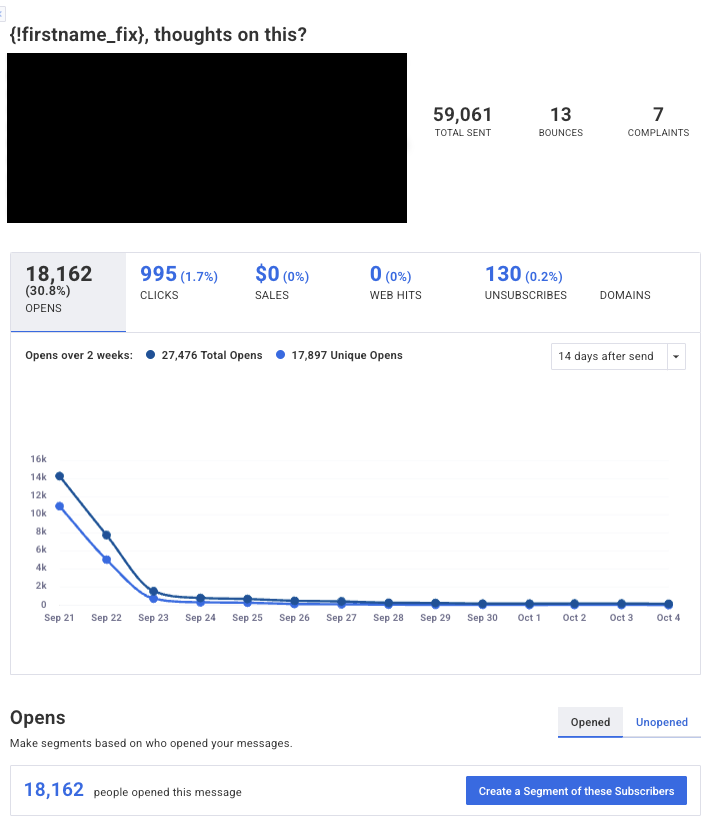
So what did the message look like?
This was the subject line:
Notice it doesn’t say something lame like, “Please fill out this survey.”
We wanted them to click and read further.
If they do, there’s a higher chance they’ll respond. Plus, “survey” implies work from the subscriber. Instead, our email evokes curiosity.
The subject line, “Thoughts on this?” could be about anything!
People are naturally curious.
The word “this” draws people into the email. Including their name adds another layer of attention. Some marketers think it’s overdone, but guess what?
It works.
People pay attention to their names.
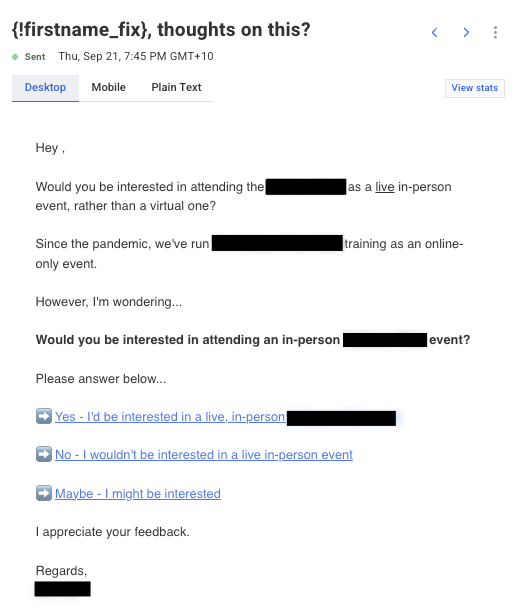
It’s short.
No bells.
No whistles.
Just one goal: Get interested people to click.
Too many marketers blabber and don’t get to the point. We kept it short out of respect for our subscribers’ time. This email gauged who was interested in attending the live in-person event.
We tagged each person with a “yes,” “maybe,” or “no” tag.
Next, over 50 days, we sent 9 emails to everyone who said “yes” and “maybe.” (Each email was sent one week apart, except for the 10th email.)
Here’s what we sent…
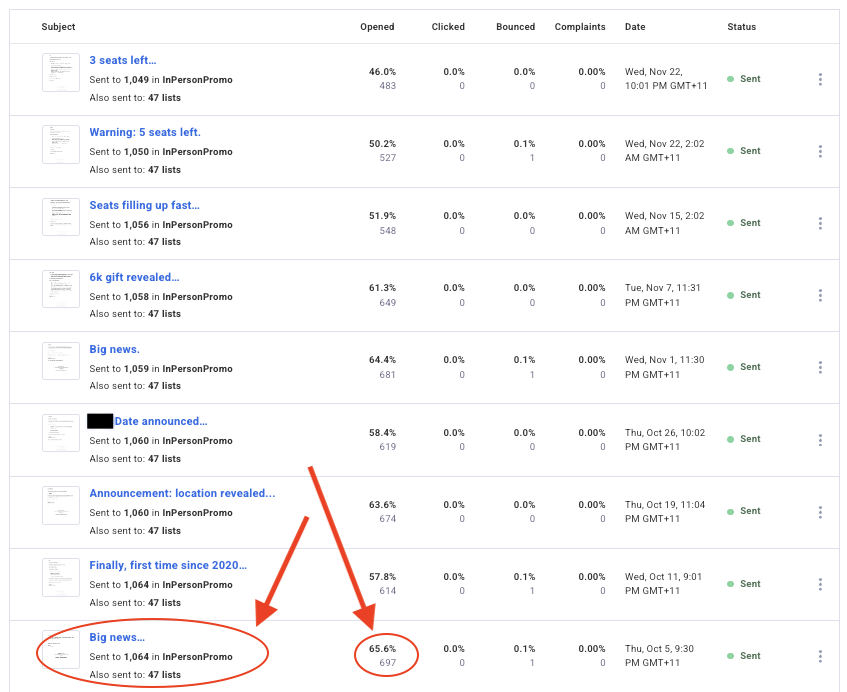
Email 2 of 10: The Announcement
This email got a huge open rate.
In fact, we sent two emails with the subject “big news.”
Oops.
That was a genuine mistake.
Still, BOTH those emails pulled the highest open rates during the entire promotion.
(And yes, due to Apple’s Mail Privacy Protection, these numbers are skewed. Whatever.)
There were zero clicks for these emails because people were asked to reply to the email.
Why such a simple subject line?
Why such a high open rate?
“Big news…” is a genius subject line.
Here’s why:
- Curiosity. People want to stay up to date. When two people see each other, the first thing they’ll often ask is, “What’s news?”
- Incomplete Thought. Notice the “ …” at the end? That was intentional. Those three dots make people think part of the subject line is missing, so they’ll see the complete sentence if they open it. Sneaky.
- Mass Appeal. Each email should have a different appeal and hook. However, it’s best to start campaigns with broad and vague subject lines. Why? Because it gets the highest number of people to open. Will they be the most qualified prospects? No. However, that’s what the emails further down the promo are for.
- Excitement. Most people are bored. “Big news” teases that something interesting is going on.
Now, behold, the email within…
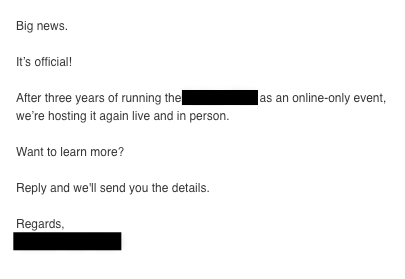
Fancy, huh?
It’s a real “Shakespeare” piece, I know.
This email goes for the lowest-hanging fruit.
People who are sold on attending.
Now that we’ve confirmed a lot of people are interested in an in-person event, we simply tell them it’s happening.
The call to action is to reply to the email.
Why?
Because it’s a high-ticket sale. It’s nearly impossible to sell a $8,000+ product via a web page.
The phrase, “Want to learn more?” gets the subscriber to say, YES in their head.
Most of the “yeses” came the week before. It was a powerful way to re-confirm the action already taken. People like to be congruent.
Email 3 of 10: The Reminder
Let’s analyze the subject…
- It’s a BLIND email to get subs to open, especially those who missed the earlier one. Meaning, they didn’t know the content of the email.
- The word, “Finally,” suggests something is happening people had been hoping for.
- Numbers in subject lines – like “2020” above – boost response because they’re visually different AND specific.
- Specificity adds credibility and makes people more curious.
Now, this was the email:
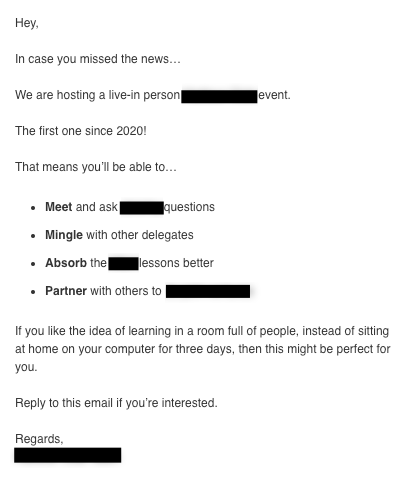
Earlier, email 2 stated the facts. This email added benefits to get more people to reply.
Also, bullets made the email more skimmable. It helped sell readers on giving up their most precious resource, their time, to read it.
We added bold emphasis to the verbs to make the bullets stand out and feel different.
Email 4 of 10: Drip Reveal
Again, the email uses a “newsworthy” angle to get the open.
63.7% ain’t too shabby.
The subject line doesn’t say something like, “Event Name: Join us in London” because we’re trying to get more people to OPEN.
Big lesson: If people KNOW what an email is about, they’re less likely to open it.
Here’s the email:
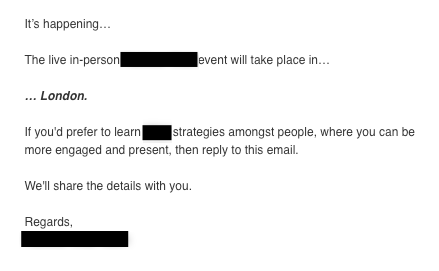
Notice how we’re DRIP feeding the information out?
If we told prospects everything in email #1, our emails would feel repetitive.
Instead, we present them with “new” information through the promo.
Email 5 of 10: Date Reveal
Another piece of info drip-fed.
Once again, we have a high open rate (58.5%) because we’re just targeting HOT prospects interested in buying.
Here’s the email message:
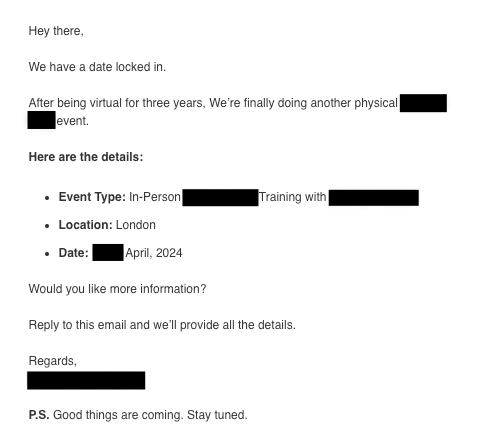
Notice how we used bold words and bullets to help the content feel skimmable and digestible?
The PS in this email is a clever psychological tactic.
By saying, “Good things are coming,” you create deeper anticipation for what’s coming next.
“Stay tuned” simply commands people to open more emails.
Email 6 of 10: The Valuable Gift
This is where we accidentally ran the same subject line again. It’s not the end of the world.
In fact, again, it got a massive open rate (64.5%)
Note: This was not a repeat of email #1.
We provided “new” news.
Here’s the email…
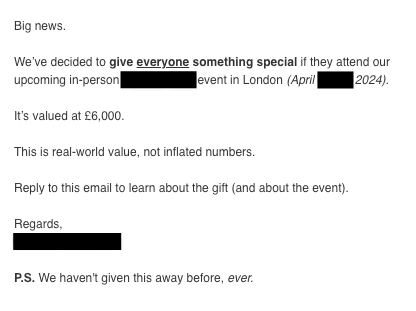
To have more people take action (i.e., reply), we beefed up the offer. We told them they’d get a gift worth £6,000 (around $7,500) if they attended.
Do you think more people reply, just to find out what the gift was?
Of course, they would.
And they did!
Whenever you say, “I’m going to offer you X bonus worth $X,” this often breeds skepticism.
Why?
Because marketers over-inflate the value of their stuff.
To alleviate this, we added, “This is real-world value, not inflated numbers.”
Would they still be skeptical?
Maybe.
Would they be more likely to reply?
You bet.
Email 7 of 10: Gift Revealed
If they didn’t reply to the last email, in this email we REVEAL the bonus.
The subject line, “6k gift revealed,” is enticing because it promises an answer to a previous question.
In copywriting, this curiosity is called an open loop.
See, people want closure. They want to know things. If they get curious and are not told, it drives them crazy.
It goes like this:
- Curious: Tease some information. (Open-loop)
- Consumed: Don’t tell them for a while.
- Closure: Reveal the info. (Closed-loop)
By the way, we use the word “gift” instead of “bonus” because the latter is a spam word.
Here’s the email…
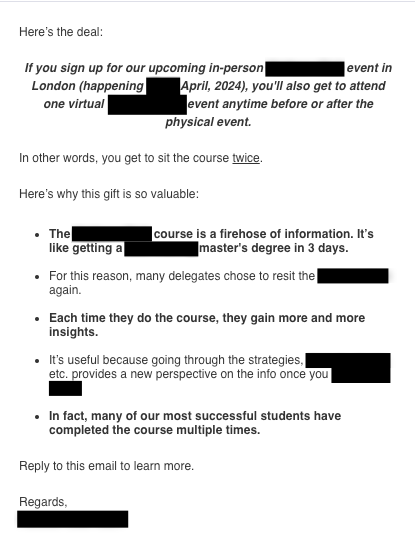
They get to sit the course twice. Now, at first glance, this seems like a strange bonus.
Again, you anticipate the subscriber’s objection, which is, “Why would I want to sit the course twice?”
The bullets then give logical reasons why it’s a good idea.
Each email is pushing more and more people to reply and get people to attend.
Email 8 of 10: Urgency
Now we shift gears.
As the deadline approached, we made the decision urgent for the prospect.
See, people are very busy. They’ve got work, the kids, social activities, bills, issues, family challenges… all sorts of things.
Your offer is not their priority.
However, if there’s a chance they might miss out, they’ll pay attention.
People are more motivated by losing something than gaining something.
Let’s see how we did this in the email…
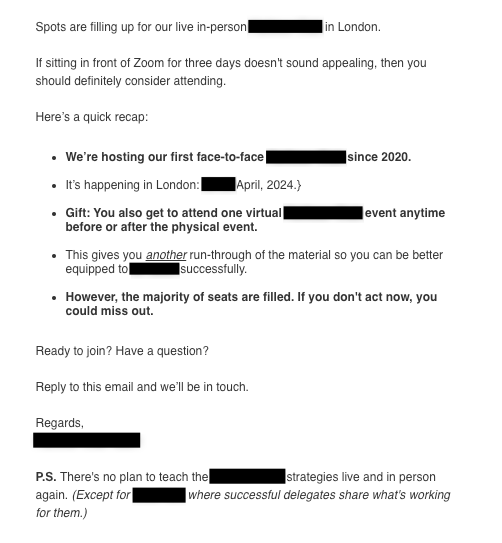
With a physical event, seats are limited by the legal capacity of the room.
Therefore, people understand there is genuine scarcity.
We appeal to the differentiation of the event being in-person rather than online by saying, “If sitting in front of Zoom for three days doesn’t sound appealing, then you should definitely consider attending.”
The bullets recap everything we’ve said earlier.
The date, location, the gift, and another call to act ‘now.’
The two questions are there to get a ‘yes’ response. Either they want to sign up or they have a question.
The P.S. added more scarcity to the situation by saying there’s no plan to run this event ever again.
Again, this overcomes the objection, “I don’t have time, I’ll take this next time.”
This is a huge objection you often need to overcome in your campaigns.
There might never be a ‘next time.’
Okay, just two emails left…
Email 9 of 10: Bigger Scarcity
“Warning” is a strong word.
It commands attention because it implies danger subconsciously.
Some companies would consider this overdramatic. In this case, for this client, it was acceptable.
Just five seats were left just a few weeks out from the event.
Highlighting this with, “5 seats left,” tells the prospect they need to take action RIGHT NOW or they’ll miss out.
It’s a powerful motivator.
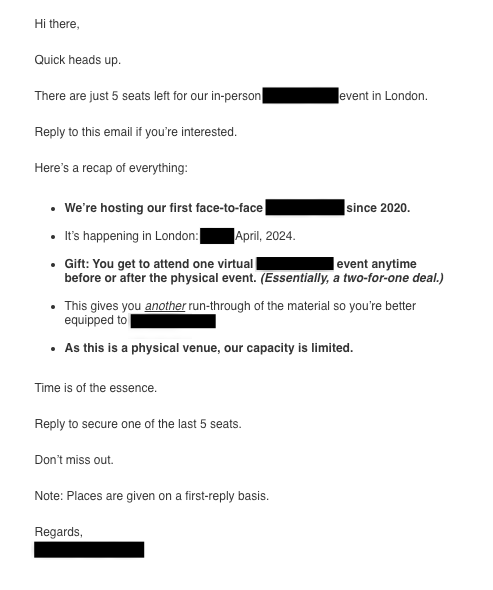
The message is reinforced and repeated in the opening of the email.
We use a call-to-action at the top of the email.
Why?
Because, at this point, most people have made up their minds. We just need to give them the nudge.
Then, we repeat the same bullets from the previous email.
We need to summarize the offer for them again.
Over half the leads missed the last email so we need to repeat the full offer and terms for them.
Email 10 of 10: The Finale
24 hours later, the client still had 3 seats left.
So we sent ONE final email to fill them up.
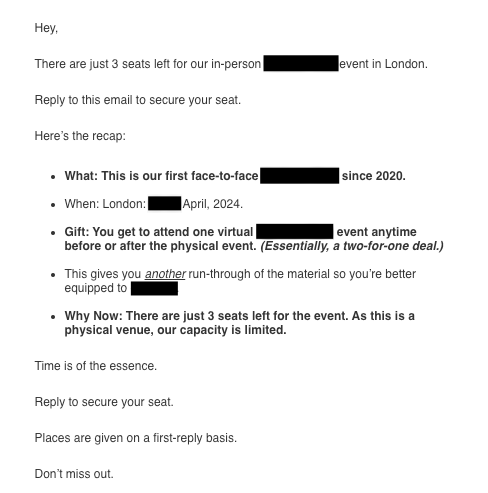
Without being too fancy, we used a basic slight variation of the previous email.
The biggest difference was the headings at the front of the bullets.
They were, “What, When, Git, Why Now.”
This provided a subtle difference to make the email feel slightly different without writing another entire email.
The line, “Places are given on a first-reply basis,” reminds them that they need to act fast.
Plus, “Don’t miss out,” makes them think of missing out and therefore more likely to act.
Phew! Okay, let’s put it all together.
The Six Big Takeaways:
Here are the big lessons from this email campaign:
- Create more offers. If your sales are sluggish and you need a quick cash injection, create new offers. In this case, the client offered a live in-person version of their event. Same product, different delivery method.
- Gauge interest. Too many creators make assumptions. They “think” they know what their subscribers want. They build a product for months. Create a sales page. Craft an email promotion. And then… zero sales. In this case, if the ‘yes’ numbers were low, we would have moved on. There would be no point in running the seminar. This verified (with data) that there was demand for the physical event.
- Follow up with hot prospects. Instead of hard-pitching 59,000+ subscribers and annoying the crap out of thousands of people, we only pitched the people who showed interest.
- Drip feed info. If you reveal all the information in one email – the date, location, location, bonuses – you run the risk of being repetitive and having less ‘newsworthy’ stuff to share. “Newsy” content is engaging. Use it to your advantage.
- Keep emails short. People are busy. Each medium has different expectations of how long people spend on them. E.g. reading a book, email, blog posts, etc. Keep everything short. Use • bullets, bold and underlined words to slow skimmers down and have them read the entire email.
- Be relevant. Why did 8 of our emails get an open rate of over 50.2%? Because we only targeted hot prospects. Real potential buyers. The first email gauged interest. That means higher opens, fewer spam complaints, and fewer unsubscribes.
Did any of this go in your noggin’?
Hopefully, this was more valuable than some generic article that regurgitates the same stuff everyone else says.
Did you get value from this?
Share this article on Twitter/X, LinkedIn, or Email with your chums.